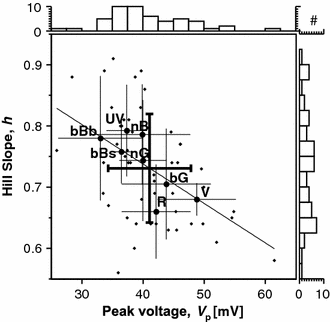An expanded set of photoreceptors in the Eastern Pale Clouded Yellow butterfly, Colias erate
- PMID: 20524001
- PMCID: PMC2890080
- DOI: 10.1007/s00359-010-0538-0
An expanded set of photoreceptors in the Eastern Pale Clouded Yellow butterfly, Colias erate
Abstract
We studied the spectral and polarisation sensitivities of photoreceptors of the butterfly Colias erate by using intracellular electrophysiological recordings and stimulation with light pulses. We developed a method of response waveform comparison (RWC) for evaluating the effective intensity of the light pulses. We identified one UV, four violet-blue, two green and two red photoreceptor classes. We estimated the peak wavelengths of four rhodopsins to be at about 360, 420, 460 and 560 nm. The four violet-blue classes are presumably based on combinations of two rhodopsins and a violet-absorbing screening pigment. The green classes have reduced sensitivity in the ultraviolet range. The two red classes have primary peaks at about 650 and 665 nm, respectively, and secondary peaks at about 480 nm. The shift of the main peak, so far the largest amongst insects, is presumably achieved by tuning the effective thickness of the red perirhabdomal screening pigment. Polarisation sensitivity of green and red photoreceptors is higher at the secondary than at the main peak. We found a 20-fold variation of sensitivity within the cells of one green class, implying possible photoreceptor subfunctionalisation. We propose an allocation scheme of the receptor classes into the three ventral ommatidial types.
Figures











References
-
- Arikawa K. Color vision. In: Eguchi E, Tominaga Y, editors. Atlas of arthropod sensory receptors. Tokyo: Springer-Verlag; 1999. pp. 23–32.
-
- Arikawa K, Stavenga DG. Random array of colour filters in the eyes of butterflies. J Exp Biol. 1997;200:2501–2506. - PubMed
-
- Arikawa K, Uchiyama H. Red receptors dominate the proximal tier of the retina in the butterfly Papilio xuthus. J Comp Physiol A. 1996;178:55–61. doi: 10.1007/BF00189590. - DOI
-
- Arikawa K, Inokuma K, Eguchi E. Pentachromatic visual system in a butterfly. Naturwissenschaften. 1987;74:297–298. doi: 10.1007/BF00366422. - DOI
Publication types
MeSH terms
Substances
LinkOut - more resources
Full Text Sources

